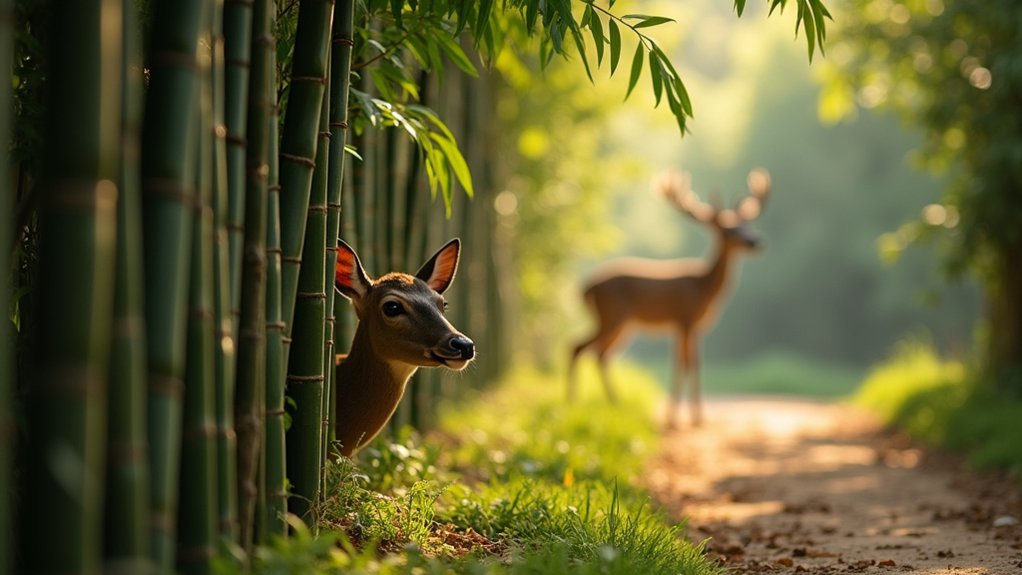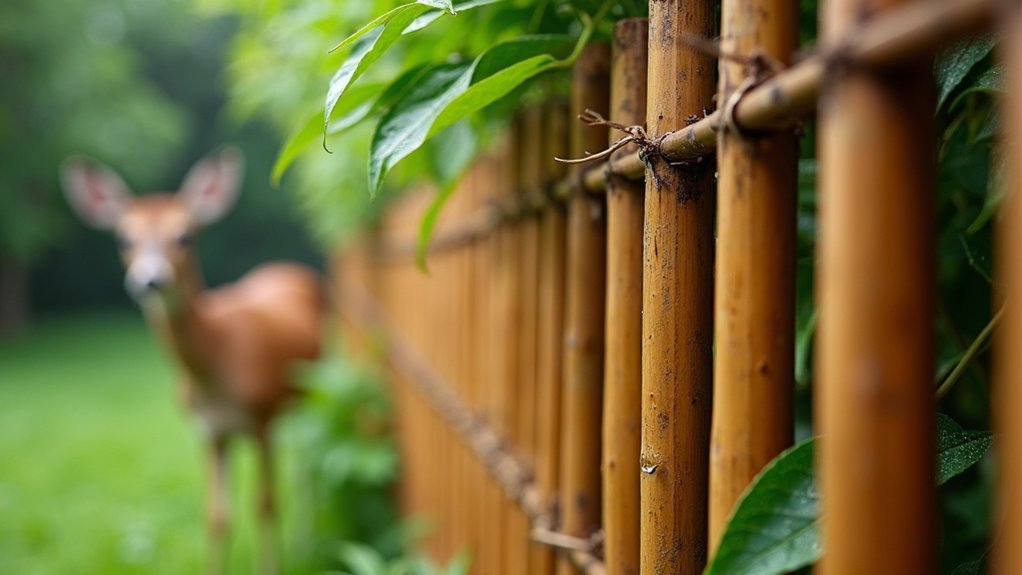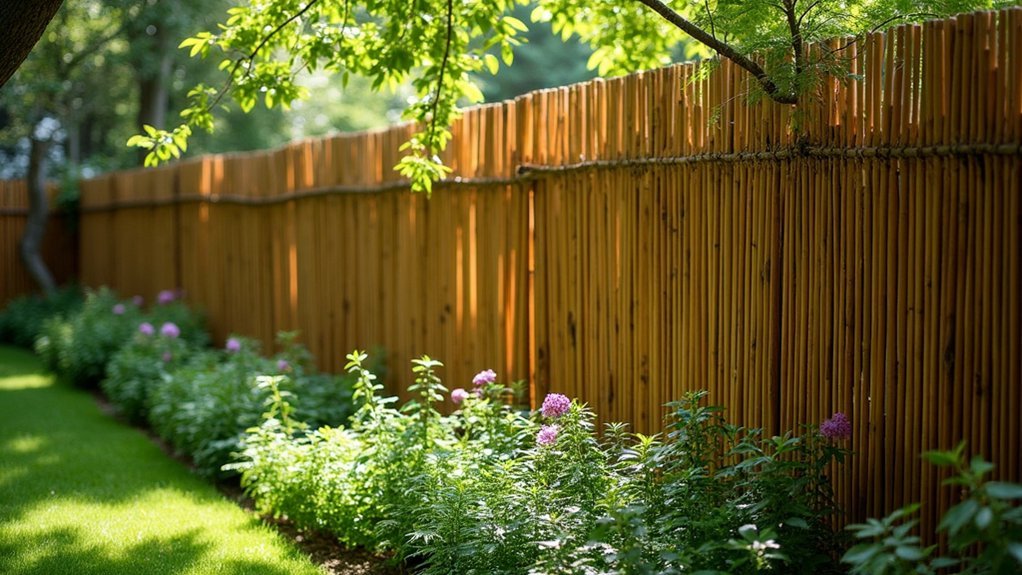Bamboo fences that actually deter deer need to be at least 6-8 feet tall with dense, tightly woven culms that block sightlines. You’ll get best results from clumping varieties planted without gaps, especially on slopes where deer feel uncertain about jumping. Combine your bamboo with wire mesh at vulnerable points for enhanced protection. With proper maintenance, these sustainable barriers can protect your garden for up to 20 years while maintaining natural aesthetics. The sections below reveal proven designs that consistently outsmart even persistent deer.
Understanding Deer Behavior and Bamboo Barrier Effectiveness

While many gardeners struggle with persistent deer damage, understanding how these cautious creatures interact with physical barriers can help you create effective protection.
Deer naturally avoid obstacles, making dense bamboo an excellent psychological deterrent for your garden.
The tall, thick growth of bamboo—especially when it reaches 6-8 feet—creates a visual barrier that intimidates deer and prevents easy navigation. This effectiveness increases in hilly areas where deer are reluctant to attempt risky jumps that could result in injury.
Remember that bamboo’s effectiveness isn’t guaranteed; you’ll need to monitor deer activity, particularly at the edges of your bamboo barrier where curious deer might still explore if attracted by nearby food sources.
Despite its barrier effectiveness, consider containment strategies for running bamboo varieties to prevent unwanted spread.
Traditional Woven Bamboo Fence Designs That Deter Deer
Because traditional woven bamboo fences combine aesthetics with functionality, they’ve become a preferred solution for gardeners battling persistent deer problems. For maximum effectiveness, you’ll need to construct your bamboo fence at least 6-8 feet tall to prevent deer from jumping over it.
Incorporate horizontal culms into your design to maintain structural integrity while allowing sunlight to reach your plants. Adding diagonal supports throughout the woven structure prevents drooping and guarantees your deterrent remains taut and effective long-term.
Choose thicker bamboo culms and weave them tightly to create a dense barrier that deer can’t push through.
Don’t forget that regular maintenance is essential—prune overgrowth and check for weaknesses that might compromise your fence’s effectiveness. This traditional woven approach offers a natural-looking solution that keeps deer at bay.
Height and Density Requirements for Deer-Proof Bamboo Barriers

To create a truly effective deer barrier, you’ll need to understand the critical relationship between height and density in bamboo installations. Deer typically won’t attempt to clear barriers exceeding 6-8 feet tall, making this the minimum recommended height for your bamboo fence.
Density plays an equally important role. Clumping bamboo varieties create naturally impenetrable barriers due to their tight growth pattern and multiple stems. You’ll want to plant bamboo closely together to eliminate gaps that deer might exploit.
For maximum effectiveness, consider your landscape’s topography. Install your bamboo barrier to grow upward on slopes, as the steep incline combined with the fence height creates a more formidable obstacle.
The solid culms also disrupt deer sightlines, adding another layer of psychological deterrence to your physical barrier.
Combining Bamboo With Other Natural Materials for Enhanced Protection
Although bamboo creates an impressive stand-alone barrier, its effectiveness against persistent deer multiplies when combined with complementary natural materials.
When constructing your bamboo as a fence, consider integrating other elements to bolster structural integrity and prevent deer intrusion into your garden area.
- Pair woven bamboo panels with wooden posts or thicker logs to increase height and density, creating a more challenging obstacle for jumping deer.
- Incorporate wire mesh between bamboo sections to reinforce weak points while maintaining a natural aesthetic.
- Add thorny plants or dense shrubs alongside your bamboo barrier to create multiple deterrent layers.
- Use biodegradable materials like jute or hemp for securing bamboo sections, enhancing durability while keeping your approach eco-friendly.
These combinations create visual obstructions that confuse deer and considerably reduce their willingness to breach your garden boundary.
Maintenance and Longevity of Bamboo Deer Fencing Solutions

While bamboo offers exceptional durability as a deer barrier, your fence’s longevity depends greatly on proper maintenance practices.
With proper care, your bamboo deer fence can last 10-20 years, making it a cost-effective solution for property protection.
Regular inspections are essential—check for invasive shoots, remove dead culms, and verify structural integrity remains intact.
Installing a rhizome barrier during construction prevents uncontrolled spreading, preserving your fence’s effectiveness against deer intrusions.
Bamboo’s natural pest resistance contributes to its durability, but don’t neglect periodic examinations for environmental damage.
For maximum longevity, incorporate diagonal supports during installation and maintain proper spacing between posts. This strengthens your fence against persistent deer pressure.
Frequently Asked Questions
What Is the Most Effective Deer Fence?
The most effective deer fence is at least 8 feet tall. You’ll get best results with a two-tiered system using woven polytape that combines physical barriers with electric deterrents that deer won’t jump over.
What Are the Disadvantages of Bamboo Fence?
Bamboo fences require regular maintenance, have high initial costs, attract pests, and can become invasive. You’ll need to monitor them constantly, and they won’t always stop determined deer from pushing through or jumping over.
Are Bamboo Deer Resistant?
Yes, bamboo is deer resistant. You’ll find its dense growth pattern, stiff culms, and sharp edges naturally deter deer. While not completely deer-proof, it’s an effective barrier when you plant it strategically around your garden.
Do Invisible Fences Work for Deer?
Yes, invisible electric fences can work for deer if you install multiple strands at different heights and maintain them properly. You’ll need consistent electricity and regular weed clearing to keep them effective as psychological barriers.
In Summary
You’ll find that truly deer-proof bamboo fences combine proper height (at least 8 feet), tight spacing, and strategic design. Whether you’ve chosen traditional woven barriers, rolled bamboo screens, or combination approaches with wire mesh, remember that maintenance is essential for long-term protection. Regular inspections and repairs will keep your barrier effective, while natural deterrents like deer-resistant plantings add an extra layer of security for your garden.





Leave a Reply